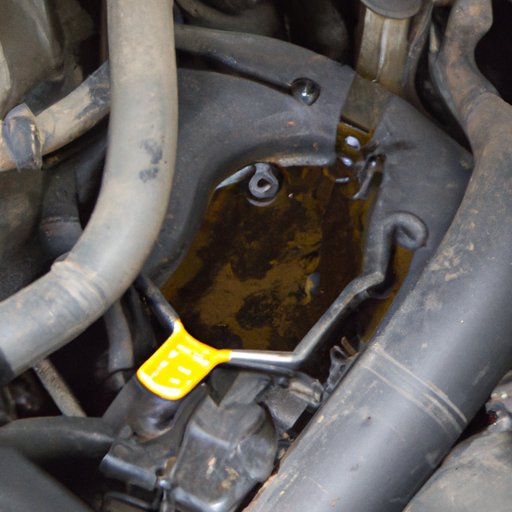
Introduction
Checking your engine oil level is an essential aspect of vehicle maintenance. Your car’s engine needs lubricant to prevent excess friction and overheating, and proper oil levels ensure that your car runs smoothly and efficiently.
However, knowing how to check your oil and understanding what to look for can be challenging if you don’t know where to start. In this article, we will provide a step-by-step guide on how to check your oil, common mistakes to avoid, and maintenance tips to keep your engine running smoothly.
Step-by-Step Guide
The following is a general overview of how to check your oil levels:
- Park your car on level ground.
- Locate the dipstick under the hood.
- Remove the dipstick and wipe it clean with a rag or paper towel.
- Reinsert the dipstick and then remove it again to check the oil level.
- Refer to the dipstick’s markings to determine if the oil level is adequate.
It’s essential to check the oil levels when the engine is cold and on level ground, as this provides an accurate reading.
The location of the dipstick can vary depending on the make and model of your vehicle. Most cars will have a dipstick with a brightly colored handle, such as yellow or orange. Check your vehicle’s owner’s manual for more information on where to find the dipstick.
Once you’ve located the dipstick, remove it and wipe it clean with a rag or paper towel. Reinsert the dipstick, making sure it goes all the way in, and then remove it again to check the oil level.
The dipstick will have markings that indicate a ‘safe zone’ or ‘full’ level. If the oil level is below the minimum safe level, add the recommended type and amount of oil. If the oil level is above the maximum safe level, drain some oil until it falls within the safe zone. Repeat this process until the oil level is adequate.
Visual Guide
We’ve included high-quality photographs and illustrations to accompany the step-by-step guide. This visual guide highlights the locations of the dipstick, oil filler cap, and other essential components, making the instructions more straightforward to understand. We also use arrows and captions to make the instructions clearer.
Video Tutorial
To further assist in the checking of oil levels, we created a short video tutorial that demonstrates the process. The video explains how to read the dipstick and provides additional tips or information as necessary. The video serves as a helpful visual aid that makes the process of checking oil levels more manageable.
Common Mistakes
The following are common mistakes people make when checking their oil levels:
- Not checking when the engine is cold.
- Wiping the dipstick clean with a dirty rag, affecting the accuracy of the reading.
- Ignoring warning lights on the dashboard, indicating low oil pressure or levels.
To avoid these mistakes, check your oil levels when the engine is cold and use a clean rag to wipe the dipstick. Additionally, pay attention to any warning lights on the dashboard, which could indicate low oil pressure or levels. These should be addressed promptly to avoid any damage to your vehicle’s engine.
How Often to Check
The frequency of checking oil levels depends on the type of engine and driving conditions. Internal combustion engines should have their oil levels checked regularly, usually around every 1,000 miles. If you drive your car in severe conditions, such as extreme heat or cold, or stop-and-go traffic, you may need to check your oil levels more frequently.
Always consult the owner’s manual for your particular vehicle’s recommended mileage or time interval for oil checks.
Troubleshooting Issues
If you encounter any problems during the oil-checking process, such as a sticky dipstick or low oil pressure warning light, seek assistance promptly. It’s essential to address any issues to avoid damage to your vehicle’s engine. Take your car to a professional mechanic for an examination and all necessary repairs.
Maintenance Tips
Beyond regular oil checks and maintenance, it’s essential to change your oil periodically, as per the manufacturer’s recommendations. The frequency varies between different types of engines and oil types and the type of driving you do. Consult your owner’s manual for the recommended interval for changing oil.
It’s also essential to choose the right oil for your car’s engine and maintain it correctly. Most cars prefer a particular type of oil, so check your owner’s manual. Some newer cars require synthetic or synthetic blend oils, which are often explicitly labeled. With these types of oils, it’s essential to stick to the recommended service intervals to avoid any problems.
Conclusion
By regularly checking your oil levels, using our step-by-step guide, and following the maintenance tips, you can keep your vehicle’s engine running smoothly and efficiently. These simple steps can help you avoid expensive engine repairs and keep your car running for many years to come.
Make this a regular part of your vehicle maintenance routine. By doing so, you’ll feel more confident that your engine is running at peak performance and that you are taking care of your car for the long term.




